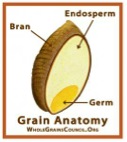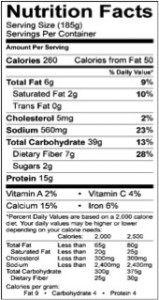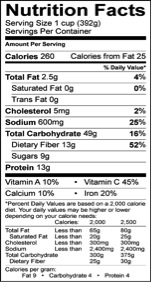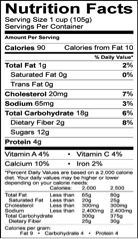 Editor’s Note: In the coming months Arizona Farm Bureau is finalizing a book regarding “Back to Basics” with nutrition and health advice from local nutritionists and other experts in the field. This article is an example of one of the chapters you’ll find when the book is released.
Editor’s Note: In the coming months Arizona Farm Bureau is finalizing a book regarding “Back to Basics” with nutrition and health advice from local nutritionists and other experts in the field. This article is an example of one of the chapters you’ll find when the book is released.
Family, Consumer, & Health Sciences Agent
U of A Pinal County Cooperative Extension
Whole Grain….what is a whole grain you ask? A whole grain is a grain that has been harvested but not processed. Processing is when important nutrients are removed from the grain and enriched. An enriched or refined grain has had nutrients such as iron and many B vitamins added back in after they are processed. A whole grain contains the entire grain kernel which consists of the bran, endosperm and the germ (Figure A) and keeps ALL the important nutrients.
Figure A
The bran section contains fiber. Fiber is very important in keeping our digestive tract regular (preventing constipation), it helps to control our blood sugar levels and lower blood cholesterol levels. The endosperm section contains the starch or carbohydrates. Carbohydrates are the energy or fuel source for our body and brain. The germ contains many B vitamins and protein. B vitamins such as folate or folic acid is especially important in child-bearing women to prevent birth defects such as spina bifida.
As you can see grains provide many important nutrients that our bodies need on a daily basis, but whole grains provide nutrients such as fiber which is not added back in after it is processed.
For most of human history we have eaten grains right off the plant stalk with minimal grinding, and when we did grind our grains we still ate every part. With the introduction of industrial roller mills in the late 19th century, the way we eat grains changed dramatically. This type of milling strips away the bran and germ making products made from grain easier to chew, digest, and easier to keep without refrigeration. The products (bread, pastries, etc.) that we can make from refined flour are fluffy and light, but we pay a price in terms of nutrition by losing more than half of wheat’s vitamin B, 90% of the vitamin E, and nearly all of the fiber.
It is very important that we try to make at least half of the grains we consume whole grains so that we receive more of the nutrients that grains have to offer. What does this mean? The recommended amount of grains for a person who is on a 2,000 calorie diet should be 6 ounces, which means 3 ounces of grains should be whole grains. But what is one ounce? The following examples equal one ounce of grains:
1 slice of bread
½ cup of cooked rice or pasta
1 cup of ready-to-eat cereal flakes
½ cup of cooked oatmeal
1 packet of instant oatmeal
1 small corn tortilla
3 cups of cooked popcorn
¼ large bagel
Since everyone is not on a 2,000 calorie diet our individual needs for grains will be different. The number of ounces of grains you should eat daily will depend on your daily calorie intake.
The grains food group consists of many, many foods we eat daily such as breads, pastas, tortillas, cereals, cookies, cakes, and the list goes on. How do you know you are eating a whole grain? By reading the ingredients label. When selecting whole grain products be sure to read the ingredients to determine if the product is a whole grain. One of the first ingredients listed should be a whole grain, such as whole wheat. Look for the ingredients whole wheat flour, bulgur, whole oats, whole-grain corn, or whole rye as one of the first ingredients on the label. Do not assume the word wheat on breads makes it a whole grain. Many brown breads are made with white flour and have coloring added in to give it the brown appearance. Read your labels carefully to determine if it is a whole grain. Another important item to look for is the fiber content on the nutrition facts label. If the product contains at least 3 grams of fiber per serving then the product is to be considered a good source of fiber.
There are many different ways to incorporate whole grains into our diets by making simple changes in the foods we already eat. For instance, do you like quesadillas? By simply buying whole wheat tortillas instead of tortillas made with refined flour you can get another whole grain into your diet. What about rice? Try substituting the whole grain quinoa for white rice. The following recipes offer some creative ways of adding whole grains into your diet, and believe it or not they are simple and yummy.
A frequent whole grain served for breakfast is cooked oatmeal. Here’s another healthy whole grain option.
Breakfast Quinoa
Ingredients:
- ½ cup uncooked quinoa
- ¾ cup skim milk
- 2 tablespoons water
- 1 tablespoon light brown sugar
- 1/8 teaspoon salt
- ¼ cup coconut, shredded
- 1 cup strawberries, sliced
- 1 cup bananas, sliced
Directions:
- Wash hands with warm water and soap.
- Rinse and drain quinoa thoroughly.
- Combine quinoa, milk, water, brown sugar and salt in medium saucepan. Bring to boil.
- Reduce heat and simmer about 10-15 minutes. Stirring occasionally.
- Pour immediately into 4 bowls and top each bowl with ¼ cup strawberries, ¼ cup bananas, and a spoonful of coconut. Serve warm.
Yield: 4 servings
This quick lunch option can also be made healthier by incorporating whole wheat tortillas instead of tortillas made with refined flour.
Black Bean & Corn Quesadilla
Ingredients:
- 1 cup canned black beans, drained and rinsed well
- 1 cup frozen or canned corn, drained
- ¼ cup prepared salsa
- 1 cup low-fat cheddar cheese
- 4 8” whole wheat tortillas
Directions:
- Wash hands with warm water and soap.
- Mix black beans, corn and salsa together in a bowl. Set aside.
- Lay tortilla on flat surface and spread tablespoon of black bean mixture on half of tortilla.
- Sprinkle ¼ cup cheese on top of bean mixture.
- Fold tortilla over and set on microwaveable plate.
- Microwave approximately 30 seconds (may vary by microwave temperature).
Yield: 4 servings
Quinoa can be substituted or become an added ingredient in many recipes that you already prepare, such as stews or chili, as in the following recipe:
Slow Cooker Quinoa Chili
Ingredients:
- 1 cup quinoa, rinsed
- 1 28-ounce can diced tomatoes (undrained)
- 1 14-ounce can diced tomatoes with green chilies (undrained)
- 1 16-ounce can black beans, drained and rinsed
- 1 15-ounce can corn, drained
- 1 15-ounce can kidney beans
- 2 cups low sodium chicken stock
- 1 large green bell pepper, seeded and chopped
- 1 onion, minced
- 1 teaspoon fresh garlic, minced
- 1 teaspoon cumin
- 1 teaspoon crushed red pepper
- 1 teaspoon chili powder
- Optional: Garnish with low fat cheese and/or low fat sour cream
Directions:
- Wash hands with warm water and soap.
- Place all ingredients in a 6 quart slow cooker and cook for 5 – 7 hours on low. Keep warm until ready to serve.
Yield: 8 servings
So now that you have had a hearty dinner of quinoa chili, what about dessert? You can prepare a delicious dessert that contains a whole grain, with very little cooking. A good example is this apple bread pudding.
Apple Bread Pudding
Ingredients:
- 2 cups fresh apples, peeled and sliced
- 2 slices 100% whole wheat bread, cut into 1” cubes
- 1 egg
- 1 tablespoon sugar
- 1 cup evaporated skim milk, canned
- 1 teaspoon vanilla extract
- ½ teaspoon ground cinnamon
Optional: ¼ cup raisins
Directions:
- Wash hands with warm water and soap.
- Preheat oven to 350 degrees.
- Lightly grease an 8” square baking dish.
- Combine apples, raisins (optional) and bread, pour into greased baking dish. Set aside.
- Beat egg and sugar in a medium bowl thoroughly. Gradually beat in milk.
- Stir in vanilla and cinnamon. Pour over bread mixture. Let stand about 30 minutes to soften bread.
- Place baking dish in a large pan. Pour enough hot water to fill the outside pan with about 1” of water.
- Bake about 30 minutes or until done. Serve warm or cool. Refrigerate leftovers.
Yield: 8 servings
Now that you have a few simple recipes that contain whole grains and were not hard to prepare or cook, let’s take a look at a whole grain snack food. Can you guess what it is? POPCORN….yes, popcorn is a whole grain and can be a healthy snack. When we air pop popcorn and do not add salt or butter we are eating a whole grain. Enjoy the popcorn, but limit the amount of salt and butter you add or try not adding any at all and instead sprinkle on a home-made pizza or ranch seasoning.
You can see that with a little creativity, making half our grains whole grains is not hard at all. By making a few simple exchanges we can get all the whole grains we need.







One Response to “Back to Basics” Nutrition Advice From Experts: Keep at Least Half of Your Grains Whole